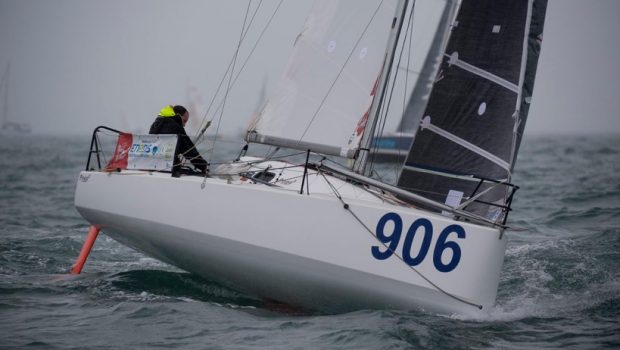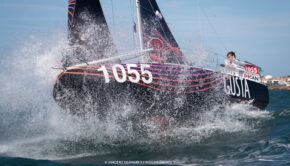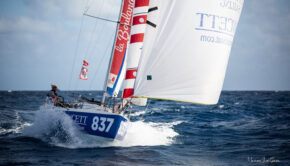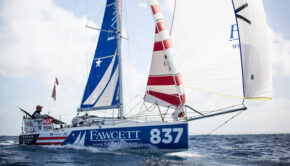Precious Little Breeze for Mini Transat
Published on October 9th, 2017
(October 9, 2017; Day 9) – As the sea takes on the look of a millpond, the skippers competing in the 2017 Mini-Transat La Boulangère are getting increasingly worried. Between the latitude of Madeira and that of the Canaries, the wind is dying and the average speeds make for depressing reading.
At this pace, there is no real prospect of a solid ETA. Both at sea and on shore, everyone will just have to grin and bear it for now. The first ETAs have shifted to Tuesday (Oct.10) night through into the next day, and the rankings are fluctuating with the position reports.
This first leg of the Mini-Transat La Boulangère may go down in the race’s history books as one of the longest of the modern era, when the competitive prototypes and production boats took over from the Muscadets and Serpentaires of the early days. In this windless stagnation, everyone is trying to find a savior in options that are increasingly uncertain. Indeed, the only certainty is that the situation is benefiting those towards the back of the fleet due to misfortune or dawdling.
La Fontaine may not have envisaged the flip side of the tale of the tortoise and the hare, whereas Jérôme Lhermitte (Noveum), Guillermo Canardo (Open Arms) and Thomas Béchaux (Poralu Marine) are embracing it with open arms. Indeed, they’ve been able to continue making steady progress, whilst also closing on the leaders slightly.
Others have not been so lucky alas. Indeed, between the tail of the fleet and a little group just to the north of the latitude of Madeira, the wind has faded away to the great displeasure of Vianney Desvignes (Effydin – Stade Français), François Denis (Soboat.com) and Boris Pelsy (Novintiss). The fruity conversations over VHF can just be imagined.
Within this context, some skippers have opted to leave things to fate, entrusting the wind gods with the keys to the boat should they dare to put in an appearance. Between Irish sailor Thomas Dolan (Offshoresailing.com), Pierre Chedeville (Blue Orange Games – Fair Retail) and Yann Burkhalter (Kalaona) sleep is a hot topic of conversation. To hear them it sounds like a pajama party is in store this evening, with a deep sleep under the quilt before breakfast on the terrace at sunrise.
Essentially, nobody really knows which way to turn given how stretched the isobars have become and how scrawny the pressure gradient is. At the mercy of each new position report, those favoring one option take precedence over others and vice versa. Yannick Le Clech (Dragobert), one of the skippers furthest over to the west, had gained the upper hand in the 15:00 UTC ranking, whilst Clarisse Crémer (TBS), one of the skippers further to the east appeared to be leading the race at the previous position report. It must be tempting to offer Neptune some sacrifices, though this may not be wise given that there’s not much left to eat aboard.
In the prototype category, Arthur Léopold-Léger (Antal-XPO) has clearly decided not to give an inch. Despite the fact that the two leaders have covered just 50 miles in the past 24 hours, he’ll be keen to instill some doubt in the direction of Ian Lipinski (Griffon.fr), for whom this would be his first defeat in two years of racing. However things pan out, there is an Atlantic left to traverse of course.
One imperative, to drink is the key to lucid sailing. As such, the rule for the Mini-Transat La Boulangère dictates that a minimum of 40 liters of water is aboard. This is easily the equivalent of 10 to 12 days of racing. However, we are well aware of the sins of offshore racers. Indeed, it’s highly likely that a few of the hotheads emptied a few bottles of water into the sea the minute La Rochelle’s towers had disappeared over the horizon in a bid to make the boat lighter.
For those who do end up short of water, a nine-liter jerrican of water must make up some of the contents of the grab bag, whose seal will have to be broken if used and the verdict will automatically go before the jury. As such, between losing a few hours from their final race time and putting their health at risk, the skippers will have to quickly make their choices.
Ranking at 15:00 UTC
Prototypes
1- Arthur Léopold-Léger – Antal XPO – 145.2 miles from the finish
2- Ian Lipinski – Griffon.fr – 14.3 miles behind the leader
3- Romain Bolzinger – Spicee.com – 44.5 miles behind the leader
4- Erwan Le Mené – Rousseau Clôtures – 62.1 miles behind the leader
5- Simon Koster -Eight Cube Sersa- 68.2 miles behind the leader
Production boats
1- Yannick Le Clech – Dragobert 203.7 miles from the finish
2- Tanguy Bouroullec – Kerhis Cerfrance – 3.2 miles behind the leader
3- Clarisse Crémer – TBS – 3.7 miles behind the leader
4- Benoit Sineau – Cachaca II – 3.8 miles behind the leader
5- Valentin Gautier – Shaman – Banque du Leman 5.3 miles behind the leader
Class news – Race news – Tracking – Facebook
Race Facts
· Sunday 1 October: Start of the Mini-Transat La Boulangère in La Rochelle, France
· 21st edition
· 4,050 miles to cover between La Rochelle – Las Palmas in Gran Canaria and Le Marin (Martinique)
· 81 skippers at the start
· 10 women
· 11 nationalities
· 20 years: age of the youngest skipper in the race: Erwan Le Draoulec
· 62 years: age of the oldest skipper in the race: Fred Guérin
· 25 prototypes
· 56 production boats
· 66 rookies
· 15 ‘repeat offenders’
Background
With an overall length of 6.50m and a sail area pushed to the extreme at times, the Mini Class offers incredibly seaworthy boats. Subjected to rather draconian righting tests and equipped with reserve buoyancy making them unsinkable, the boats are capable of posting amazing performances in downwind conditions… most often to the detriment of comfort, which is rudimentary to say the least.
The Mini Transat has two legs to carry the fleet from La Rochelle, France to Martinique, West Indies. The leg from La Rochelle to Las Palmas de Gran Canaria is a perfect introduction to proceedings before taking the big transatlantic leap.
The first leg starts on October 1, with the fleet thrust into the Bay of Biscay which can be tricky to negotiate in autumn, while the dreaded rounding of Cape Finisterre on the north-west tip of Spain marks a kind of prequel to the descent along the coast of Portugal. Statistically, this section involves downwind conditions, often coloured by strong winds and heavy seas. Making landfall in the Canaries requires finesse and highly developed strategic know-how.
The second leg begins on November 1, with the solo sailors most often carried along by the trade wind in what tends to be a little over two weeks at sea on average. At this point, there’s no way out: en route to the West Indies, there are no ports of call. The sailors have to rely entirely upon themselves to make Martinique.
Source: Aurélie BARGAT | Effets Mer









 We’ll keep your information safe.
We’ll keep your information safe.